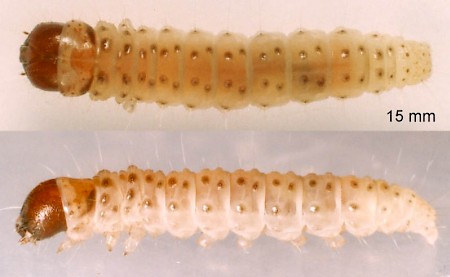29.003 BF665
Dasystoma salicella
(Hübner, 1796)
Wingspan: male 17-20 mm; female, wings vestigial, 6-10 mm.
Widespread, but local and scarce, in England and Wales. Very scarce in Scotland and Ireland. Males fly around noon on sunny April days to find the flightless females .
The larva feeds from between two overlapping leaves sewn together on a wide variety of plants including sallows (Salix), sloe (Prunus spinosa) and bog-myrtle (Myrica gale). Growth is slow and extends from May to September, when pupation occurs.
- Larva (description Ian F. Smith):
Foodplants: Polyphagous. Including Salix, Myrca gale, Prunus spinosa, Filipendula ulmaria, Potentilla anserina, Rubus fructicosus, Rhamnus, Betula and Vaccinium. Larva May - September, between two overlapping leaves sewn together with a few silk threads. (Emmet, 1988; in a folded leaf.)
Intermediate instar
Length: 10 mm (early July)
Head: Dark brown (previous instar black). Anterior periphery, mouthparts, stemmatal area and laterally; black. Frons and posterior of epicranial spheres edged blackish.
Prothorax (T1): Integument tinted rosy brown.
Prothoracic shield dark brown, divided by paler medial line. Laterally and posterior half heavily marked black. Mesothorax (T2) and Metathorax (T3): Integument coloured as rest of body.
Thoracic legs: Base coloured as body, ringed basally by a black line. Femur, tibia and tarsus superficially appear black, but under the microscope in good light the legs are translucent blackish green marked with black, most heavily on T1. On T3 the tibia is swollen and bulbous. It and the tarsus are held at right angles to the body, and rapidly drummed on a leaf if the larva is disturbed.
Body: Translucent dull whitish, coloured by gut contents. (In specimen examined T2 - A1 and A7 - A8 ochreous, A2 - A6 greenish and A9 - A10 greyish.) Ventrally, folds of integument more distinctly white.
Spiracles: Unobtrusive, coloured as body.
Pinacula: Shiny grey. Colourless base of seta surrounded by fine dark brown setal spot.
Setae: Translucent silvery.
Anal plate: Coloured as abdomen. Speckled with light brown spots and light brown setal spots.
Prolegs: Coloured as venter. Planta paler, translucent. Crochets burnt ochre.
Late instar
Length: 15 mm (early August)
Head: Chestnut brown. Surface reticulated with fine wrinkles. Anterior periphery and mouthparts pitchy brown. Clypeus translucent white. Stemmatal area black.
Prothorax (T1): Integument whitish tinted very faintly pink.
Prothoracic shield transparent, faintly tinted orange, except white anterior edge and medial dividing line. Head and viscera visible. Orange surface pigment marks laterally and near ends of medial line. Dark brown border postero-laterally. Fine black rings round colourless bases of setae; on each side of shield, three laterally and a big and a small one in posterior third.
Mesothorax (T2) and Metathorax (T3): Integument coloured as rest of body.
Thoracic legs: Transparent white with a few faint brown marks on femur. Tarsus brownish. On T3 the tibia is swollen bulbous and lighter white and more transparent than other leg parts. It and the tarsus are held at right angles to the body, and rapidly drummed on a leaf if the larva is disturbed
Body: Translucent whitish. Orange viscera of specimen examined colours dorsum of T2-T3, A1-A4 and A7. Darker contractile dorsal vessel visible A4-A7. Lighter white below spiracles and ventrally.
Spiracles: Thin reddish brown peritreme.
Pinacula: Large shiny dark grey. Colourless base of seta surrounded by fine black setal ring. Unisetose, except many bisetose or trisetose on thorax. Anterior dorsal pinacula have no seta on T2 and T3.
Setae: Translucent silvery.
Anal segment: No anal comb. Anal plate coloured as abdomen. Speckled with burnt ochre spots and pitchy brown setal rings.
Prolegs: Coloured as venter. Crochets burnt ochre.
Similar species The only other British species with swollen legs on T3 are Diurnea fagella andDiurnea phryganella. They lack the dark pinacula of Dasystoma salicella.
Rearing:Dasystoma salicella grows slowly over five months, so rearing on a potted plant is easier than maintaining a supply of fresh cut plant material. Leave outside overwinter and bring indoors in March, or keep under surveillance outdoors March and April.

 UKMoths
UKMoths 







